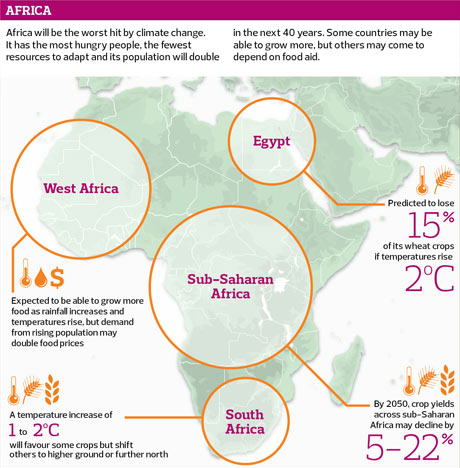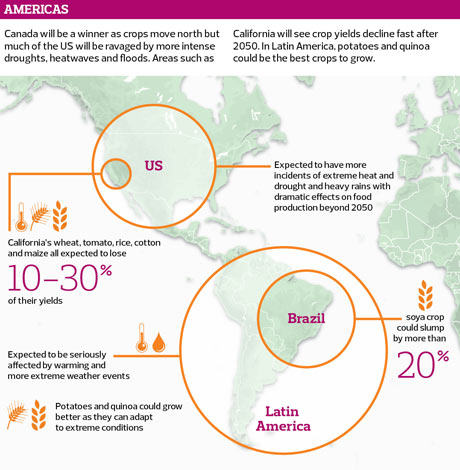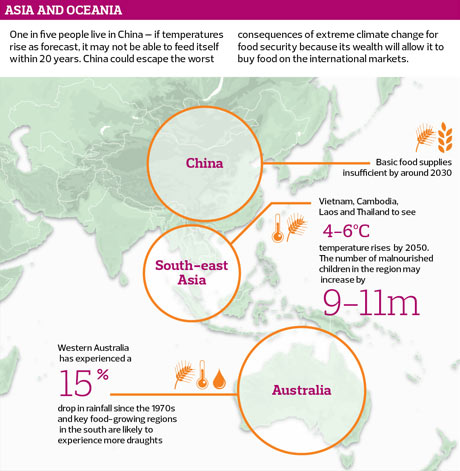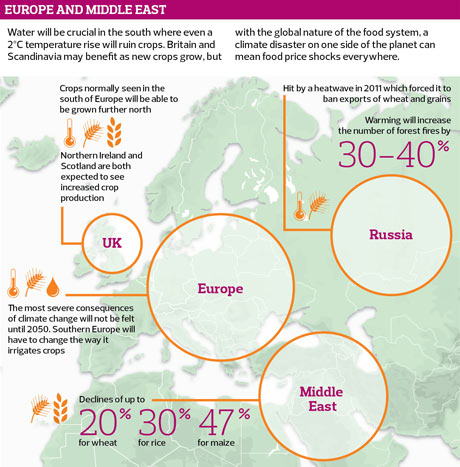Climate Crisis Threatens Millions With Starvation And Destitution
By Countercurrents.org
14 April, 2013
Countercurrents.org
Our world is not prepared to face the food disaster due to climate crisis. Parts of Africa face risk of turning into permanent disaster areas, say food experts. Millions of people could become destitute in Africa and Asia as prices of staple foods will more than double by 2050 as a result of extreme temperatures, floods and droughts that will transform the way the world farms.
As food experts gather at two major conferences to discuss how to feed the nine billion people expected to be alive in 2050, leading scientists have told the Observer (UK) that food insecurity risks turning parts of Africa into permanent disaster areas. Rising temperatures will also have a drastic effect on access to basic foodstuffs, with potentially dire consequences for the poor.
The food security summits are now being held in Ireland , organized by UN World Food Programme, the CGIAR Research Programme on Climate Change and the Mary Robinson Climate Justice foundation.
John Vidal's reports added:
Frank Rijsberman, head of the world's 15 international CGIAR crop research centers, which study food insecurity, said: "Food production will have to rise 60% by 2050 just to keep pace with expected global population increase and changing demand. Climate change comes on top of that. The annual production gains we have come to expect … will be taken away by climate change. We are not so worried about the total amount of food produced so much as the vulnerability of the one billion people who are without food already and who will be hit hardest by climate change. They have no capacity to adapt."
Political insecurity increases
The reports added:
Global warming is exacerbating political instability as tensions brought on by food insecurity rise. The issue can only get worse.
Citing a host of new studies John's reports said:
A major factor in the subsequent uprisings, which became known as the Arab spring, was food insecurity. Drought, rocketing bread prices, food and water shortages have all blighted parts of the Middle East . Analysts at the Centre for American Progress in Washington say a combination of food shortages and other environmental factors exacerbated the already tense politics of the region.
In the Middle East and north Africa, declining yields of up to 30% are expected for rice, about 47% for maize and 20% for wheat.
An as-yet unpublished US government study indicates that the world needs to prepare for much more of the same, as food prices spiral and longstanding agricultural practices are disrupted by climate change.
"We should expect much more political destabilization of countries as it bites," says Richard Choularton, a policy officer in the UN's World Food Programme climate change office. "What is different now from 20 years ago is that far more people are living in places with a higher climatic risk; 650 million people now live in arid or semi-arid areas where floods and droughts and price shocks are expected to have the most impact.
"The recent crises in the Horn of Africa and Sahel may be becoming the new normal. Droughts are expected to become more frequent. Studies suggest anything up to 200 million more food-insecure people by 2050 or an additional 24 million malnourished children. In parts of Africa we already have a protracted and growing humanitarian disaster. Climate change is a creeping disaster," he said.

Impact of climate on food in Africa . Sources: Met office, FAO. Graphic: Giulio Frigieri.
Many African countries are already experiencing longer and deeper droughts, floods and cyclones. The continent is expected to suffer disproportionately from food insecurity, due to fast-growing vulnerable populations.
Egypt expects to lose 15% of its wheat crops if temperatures rise 2C, and 36% if the increase is 4C. Morocco expects crops to remain stable up to about 2030, but then to drop quickly later.
Most north African countries traditionally import wheat and are therefore highly vulnerable to price shocks and droughts elsewhere.
A new study of 11 west African countries expects most to be able to grow more food as temperatures rise and rainfall increases. But demand from growing populations may double food prices. Climate change may mean Nigeria , Ghana and Togo can grow and export more sorghum, raised for grain.
Temperatures are expected to rise several degrees in regions close to the Sahel . In Burkina Faso , the sorghum crop is expected to decline by 25% or more, but maize yields may improve.
Other studies by IFPRI suggest crop yields across sub-Saharan Africa may decline 5-22% by 2050, pushing large numbers of people deeper into destitution.
A new UN study suggests climatic conditions in southern Africa will worsen. Climate models mostly predict an increase in annual maximum temperatures in the region of 1 to 2C by 2050. This will favor some crops but shift others to higher ground or further north.
Both of Africa 's staple crops, maize and sorghum, are expected to be badly hit by increasing severity of weather.
Oxfam warns that small-scale farmers in the Horn of Africa will bear the brunt of the negative impacts of climate change. Unpredictable weather here has already left millions semi-destitute and dependent on food aid.
Food prices to increase 40%-50%
In the Dublin conference hosted by the Mary Robinson climate justice foundation research reports say that rising incomes and growth in the global population, expected to create 2 billion more mouths to feed by 2050, will drive food prices higher by 40-50%. Climate change may add a further 50% to maize prices and slightly less to wheat, rice and oil seeds.
"We know population will grow and incomes increase, but also temperatures will rise and rainfall patterns will change. We must prepare today for higher temperatures in all sectors," said Gerald Nelson, a senior economist with the International Food Policy Research Institute in Washington .
The poorest people will be hurt most
Citing these studies John Vidal wrote:
The worst impacts will be felt by the poorest people.
Robinson, the former Irish president, said: "Climate change is already having a domino effect on food and nutritional security for the world's poorest and most vulnerable people. Child malnutrition is predicted to increase by 20% by 2050. Climate change impacts will disproportionately fall on people living in tropical regions, and particularly on the most vulnerable and marginalized population groups. This is the injustice of climate change – the worst of the impacts are felt by those who contributed least to causing the problem."
But from Europe to the US to Asia , no population will remain insulated from the huge changes in food production that the rest of the century will bring.
Inevitable instability
Frank Rijsberman said: "There's a lot of complacency in rich countries about climate change. We must understand that instability is inevitable. We already see a lot of refugees. Perhaps if a lot of people come over on boats to Europe or the US that would wake them up."
Americas

Impact of climate on food in the Americas . Sources: Met office, FAO. Graphic: Giulio Frigieri. Photograph: Giulio Frigieri
Citing a US government report John Vidal's report said:
The US economy is set to undergo dramatic changes over the next three decades, as warmer temperatures devastate crops. The draft US National Climate Assessment report predicts that a gradually warming climate and unpredictable severe weather, such as the drought that last year spread across two-thirds of the continental United States , will have serious consequences for farmers.
The research by 60 scientists predicts that all crops, livestock and fruit harvests will be affected by the temperature shift. The changing climate, it says, is likely to lead to more pests and less effective herbicides. The $50bn Californian wine industry could shrink as much as 70% by 2050.
Mentioning rising incidence of weather extremes and increased climate disruptions in the recent past the report lays bare the stark consequences for the $300bn US farm industry:
"Many agricultural regions will experience declines in crop and livestock production.”
It said:
These will have increasingly negative impacts on crop and livestock production.
It added:
Climate disruptions are projected to increase further over the next 25 years.
The reports said:
"Critical thresholds are already being exceeded. Many regions will experience declines in crop and livestock production from increased stress due to weeds, diseases, insect pests and other climate change-induced stresses. Climate disruptions to agricultural production have increased in the recent past and are projected to increase further".
Lead author Jerry Hatfield, director of the US government's national laboratory for agriculture and the environment, said that climate change was already causing weather extremes to worsen. Very hot nights, fewer cool days and more heatwaves, storms and floods have already devastated crops and will have "increasingly negative" impacts, he said.
The report follows recent disastrous harvests in Russia , Ukraine , Australia and the US . In 2010, climate-driven factors led to a 33% drop in wheat production in Russia and a 19% drop in Ukraine . Separate climate events in each case led to a 14% drop in Canada 's wheat output, and a 9% drop in Australia .
The US is expected to grow by 120 million people by 2050. Government scientists expect more incidents of extreme heat, severe drought, and heavy rains to affect food production. The warming is expected to continue without undue problems for 30 years but beyond 2050 the effects could be dramatic with staple crops hit.
According to the latest government report, "The rising incidence of weather extremes will have increasingly negative impacts on crop and livestock productivity, because critical thresholds are already being exceeded." Many agricultural regions of the US will experience declines.
California 's central valley will be hard hit with sunflowers, wheat, tomato, rice, cotton and maize expected to lose 10-30% of their yields, especially beyond 2050. Fruit and nut crops which depend on "winter chilling" days may have to relocate. Animals exposed to many hot nights are increasingly stressed. Many vegetable crops will be hit when temperatures rise only a few degrees above normal.
Nearly 20% of all US food is imported, so climate extremes elsewhere will also have an effect. In 2011, 14.9% of US households did not have secure food supplies and 5.7% had very low food security.
Because few crops can withstand average temperature rises of more than 2C, Latin America expects to be seriously affected by a warming climate and more extreme weather. Even moderate 1-2C rises would cause significant damage to Brazil , one of the world's biggest suppliers of food crops. Brazilian production of rice, beans, manioc, maize and soya are all expected to decline, with coffee especially vulnerable.
Other studies suggest Brazil 's massive soya crop, which provides animal feed for much of the world, could slump by more than 25% over the next 20 years.
Two major crops should do well: quinoa and potatoes.
Mekong Basin
Citing a US government-funded study of the fertile Lower Mekong basin that includes Vietnam , Cambodia , Thailand and Laos the John Vidal's reports stated:
Temperatures in the region could rise twice as much as previously expected, devastating food supplies for the 100 million people expected to live there by 2050. "We've found that this region is going to experience climate extremes in temperature and rainfall beyond anything that we expected", says Jeremy Carew-Reid, author of the Climate Change Adaptation and Impact Study for the Lower Mekong .
The Lower Mekong region is prone to weather extremes, could also see rainfall increase 20% or more in some areas, reducing the growth of rice and other staple crops. Many provinces will see food production decline significantly. The number of malnourished children in the region may increase by 9 to 11 million by 2050.
Ertharin Cousin, the UN's World Food Programme director, said: "We are entering an uncertain and risky period. Climate change is the game changer that increases exposure to high and volatile food prices, and increases the vulnerability of the hungry poor, especially those living in conflict zones or areas of marginal agricultural productivity. We must act quickly to protect the world's poorest people."

Impact of climate on food in Asia and Oceania . Sources: Met office, FAO. Graphic: Giulio Frigieri
China 's resilience
John's reports added:
China is relatively resilient to climate change. Its population is expected to decline by up 400 million people this century, easing demand on resources, and it has the capacity to buy in vast quantities of food.
But because more and more Chinese are changing to a more meat-based diet, its challenges will be land and cattle feed. Climate change will affect regions in different ways, but many crops are expected to migrate northwards.
Crop losses are increasingly being caused by extreme weather events, insect attacks and diseases. The 2011 drought lifted food prices worldwide. Wheat is becoming harder to grow in some northern areas of China as the land gets drier and warmer.
In southern China , droughts in recent years have replaced rainy seasons. The national academy of agricultural sciences expects basic food supplies to become insufficient around the year 2030.
Australia
Extreme events will increasingly affect agriculture in Australia . Key food-growing regions in the south are likely to experience more droughts in the future, with part of western Australia having already experienced a 15% drop in rainfall since the mid-1970s.
The number of record-breaking hot days in Australia has doubled since the 1960s, also affecting food output.
Europe
Crops normally seen growing in the south of Europe will be able to be grown further north. This would allow more sweetcorn, grapes, sunflowers, soya and maize to be grown in Britain . In Scotland , livestock farming could
become more suitable. At the higher latitudes warmer temperatures are predicted to lengthen and increase the intensity of the growing season. But more CO2 and a major temperature rise could cut yields by around 10% later in the century.

Impact of climate on food in Europe and the Middle East. Sources: Met office, FAO. Graphic: Giulio Frigieri. Photograph: Giulio Frigieri
Citing latest EU projections John reported:
The most severe consequences of climate change will not be felt until 2050. But significant adverse impacts are expected earlier from more frequent and prolonged heatwaves, droughts and floods. Many crops now grown in southern Europe , such as olives, may not survive high temperature increases. Southern Europe will have to change the way it irrigates crops.
It added:
In Europe 's high and middle latitudes, global warming is expected to greatly expand the growing season. Crops in Russia may be able to expand northwards but yields will be much lower because the soils are less fertile. In the south, the climate is likely to become much drier which will reduce yields. In addition, climate change is expected to make water resources scarcer and encourage weeds and pests.
In 2011, Russia banned wheat and grain exports after a heatwave. Warming will increase forest fires by 30-40%. This will affect soil erosion and increase the probability of floods.
The link between hunger, nutrition and climate justice is the focus of an international conference in Dublin . The impact of climate change on the lives of millions of people living on the frontlines of hunger is in the agenda. [2]
Communities that have been affected by climate change can no longer depend on their immediate environment to provide basic needs such as food, water and energy, and this exacerbates their vulnerability, increasing the risk of hunger and under-nutrition.
Source:
[1] The Observer, Apr. 13, 2013 , “Millions face starvation as world warms, say scientists”,
http://www.guardian.co.uk/global-development/2013/apr/13/climate-change-millions-starvation-scientists and The Observer, Apr. 13, 2013 , “ Climate change: how a warming world is a threat to our food supplies”,
http://www.guardian.co.uk/environment/2013/apr/13/climate-change-threat-food-supplies
[2] WFP NEWS, April 11, 2013 , “ Dublin Conference To Highlight Links Between Hunger And Climate”,
http://www.wfp.org/stories/dublin-conference-highlight-links-between-hunger-and-climate
Comments are moderated


